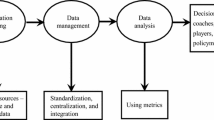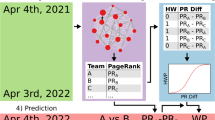Abstract
Many gamblers and most fans, players, and coaches offer causal explanations for long runs of good or bad performance in sports and financial analysts are quick to offer explanations for the daily performance of the stock market. The records of professional basketball and baseball teams and the Dow Jones daily closing average for a ten year period were evaluated for trends (streaks). The records of teams were also evaluated to assess whether the record against opponents, the home court or home field advantage, and—for baseball teams—the record of the winning and losing pitcher (excluding the current game) predicted the outcome of individual games. Recent performance is, at best, a very weak predictor of current performance and the three best predictors for baseball (pitching, home field, and record against opponent) together accounted for only 1.7% of the variance in the outcomes of individual games. We overestimate our ability to predict. This overconfidence is likely to play a role in maintaining gambling behaviors.
Similar content being viewed by others
References
Abelson, R.P. (1985). A variance explanation paradox: When a little is a lot.Psychological Bulletin, 97, 129–133.
Andreassen, P.B. (1987). On the social psychology of the stock market: Aggregate attributional effects and the regression of predictions.Journal of Personality and Social Psychology, 53, 490–496.
Baron, J., & Hershey, J.C. (1988). Outcome bias in decision evaluation.Journal of Personality and Social Psychology, 54, 569–579.
Corney, W.J., & Cummings, W.T. (1985). Gambling behavior and information processing biases.Journal of Gambling Behavior, 1, 111–118.
Daily price record. (1980–1989, 40 volumes). New York: Standard & Poor's Corporation.
Dawes, R.M. (1988).Rational choice in an uncertain world. New York: Harcourt, Brace, Jovanovich.
Fama, E.F. (1965a). The behavior of stock market prices.Journal of Business, 38, 34–105.
Fama, E.F. (1965b). Tomorrow on the New York Stock Exchange.Journal of Business, 38, 285–299.
Frank, M.L., & Smith, C. (1989). Illusion of control and gambling in children.Journal of Gambling Behavior, 5, 127–136.
Gebotys, R.J., & Claxton-Oldfield, S.P. (1989). Errors in the quantification of uncertainty: A product of heuristics or minimal probability knowledge base?Applied Cognitive Psychology, 3, 237–250.
Gilovich, T. (1983). Biased evaluation and persistence in gambling.Journal of Personality and Social Psychology, 44, 1110–1126.
Gilovich, T., Vallone, R., & Tversky, A. (1985). The hot hand in basketball: On the misperception of random sequences.Cognitive Psychology, 17, 295–314.
Hood, D.C., (1988). Toward understanding stock market movements: A marriage of psychology and economics.Science and Public Policy Seminars, Federation of Behavioral, Psychological, and Cognitive Sciences.
King, K.K. (1990). Neutralizing marginally deviant behavior: Bingo players and superstition.Journal of Gambling Studies, 6, 43–61.
Kunda, Z. (1987). Motivated inference: Self-serving generation and evaluation of causal theories.Journal of Personality and Social Psychology, 53, 636–647.
Langer, E.J. (1975). The illusion of control.Journal of Personality and Social Psychology, 32, 311–328.
Lerner, M.J. (1980).The belief in a just world: A fundamental delusion. New York: Plenum Press.
Levy, R.A. (1968).The relative strength concept of common price forecasting. New York: Larchmont.
Malkiel, B.G. (1990).A random walk down Wall Street. New York: W.W. Norton.
Osborne, M.F.M. (1959). Brownian motion in the stock market.Operations Research, 7, 145–178.
Osborne, M.F.M. (1962). Periodic structure in the Brownian motion of stock prices.Operations Research, 10, 345–379.
Sachare, A., & Sloan, D., (Eds.). (1989).The sporting news 1989–90 official NBA guide. St. Louis, Mo.: The Sporting News.
Schacter, S., Hood, D.C., Andreassen, P., & Gerin, W. (1986). Aggregate variables in psychology and economics: Dependence and the stock market. In B. Gilad & S. Kaish (Eds.),Handbook of behavioral economics (Vol. B, pp. 237–272). London: JAI Press Inc.
Shaffer, H.J., & Gambino, B. (1989). The epistemology of “addictive disease”: Gambling as predicament.Journal of Gambling Behavior, 5, 211–229.
Sloan, D., & Zesch, S. (Eds.). (1989).The sporting news official baseball guide. St. Louis, Mo.: The Sporting News.
Tversky, A., & Kahneman, D. (1971). The belief in the “law of small numbers.”Psychological Bulletin, 76, 105–110.
Wagenaar, W.A. (1970). Subjective randomness and the capacity to generate information. In A.F. Sanders (Ed.),Attention and performance III, Acta Psychologica,33, 233–242.
Wagenaar, W.A. (1988).Paradoxes of gambling behavior. London: Erlbaum.
Author information
Authors and Affiliations
Additional information
Thanks are due Janet Besaw, Raymond Frankmann, Neal Schmitt, and Rose Zacks. Robyn Dawes, while not making any specific comments on this manuscript, made a number of useful suggestions.
Rights and permissions
About this article
Cite this article
Wood, G. Predicting outcomes: Sports and stocks. J Gambling Stud 8, 201–222 (1992). https://doi.org/10.1007/BF01014636
Issue Date:
DOI: https://doi.org/10.1007/BF01014636




